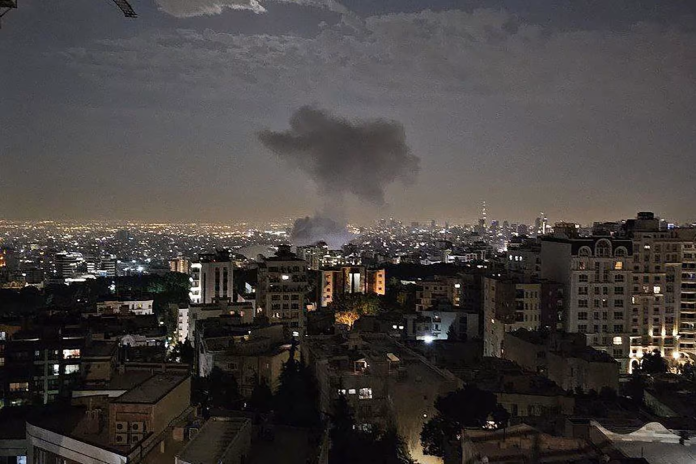Israel executed an unprecedented aerial campaign against targets within Iran, with Israeli military spokesperson confirming the involvement of 200 planes delivering over 330 munitions.
In response, Iran launched Shahed-136 kamikaze drones towards Israel. Footage of these launches emerged from Iraq’s southern Diyala province and eastern Syria. The spokesperson stated Iran deployed over 100 drones. Israeli airspace is currently closed in anticipation of retaliatory strikes.
Key developments and losses
The operation resulted in significant losses within Iran’s senior military and scientific leadership. Iran’s Tasnim news agency confirmed the death of Major General Mohammad Bagheri, Chief of Staff of the Iranian Armed Forces, in an Israeli airstrike. Habibollah Sayyari has been appointed as the interim Chief of Staff.
Tasnim also confirmed the death of Major General Gholam Ali Rashid, commander of the Central Headquarters of Khatam al-Anbiya. Notably, this headquarters was separated from the General Staff in 2016, becoming an independent command responsible for operational control.
Furthermore, Tasnim reported the death of Hossein Salami, Commander of the Islamic Revolutionary Guard Corps (IRGC). Brigadier General Ahmad Vahidi has been named interim IRGC Commander.
The strikes also claimed the lives of prominent Iranian scientists. Among the casualties were nuclear scientist Fereydoon Abbasi-Davani, former head of the Organisation for Atomic Energy, and theoretical physicist Mohammad Mehdi Tehranchi, head of the Central Tehran Branch of Islamic Azad University. Abbasi-Davani survived an assassination attempt in 2010 involving a bomb attached to his car.
Israeli Prime Minister Benjamin Netanyahu personally confirmed that Israeli Air Force (IAF) jets struck the uranium enrichment facility at Natanz.
Iran has produced enough highly enriched uranium for nine atom bombs, nine. In recent months, Iran is taking steps that it has never taken before, steps to weaponise this enriched uranium. And if not stopped, Iran could produce a nuclear weapon in a very short time.
Additional confirmed targets included the heavy water production plant in Arak and the Khondab reactor in Isfahan, alongside dozens of military bases securing these and other sites. Footage surfaced of an Israeli airstrike on a site in Piranshahr, likely destroying a ballistic missile storage facility.
IAF strikes also hit residential buildings in Tehran. According to Iranian sources, strikes impacted locations in the Lavizan, Mahallati, and Chitgar districts. The strikes potentially targeted command elements of the IRGC or other Iranian structures, mirroring precision tactics Israel had previously employed in Lebanon and Gaza against high-ranking members of militant groups.
Reactions and geopolitical calculus
Israeli Defence Minister Israel Katz declared a state of emergency, stating:
Following the State of Israel’s preemptive strike against Iran, a missile and drone attack against the State of Israel and its civilian population is expected in the immediate future.
US President Donald Trump stated he was briefed in advance about the Israeli strikes, asserting there were “no surprises.” Trump also expressed hope that Iran would return to negotiations.
I’d love to avoid the conflict. Iran’s going to have to negotiate a little bit tougher — meaning they’re going to have to give us some things that they’re not willing to give us right now. […] Iran cannot have a nuclear weapon. Other than that, I want them to be successful. We’ll trade with them. We’ll do whatever is necessary.
Strategic context
Israel’s strike on Iran serves the interests of both Israel and the United States for distinct yet complementary reasons. For Israel, it represents an opportunity to deliver a pre-emptive blow against its primary adversary.
Despite international pressure concerning Gaza, Israel remains the sole regional state capable of executing an aerial operation on this scale, doing so with tacit American backing that facilitates defence against retaliation. This scenario aligns with Israel’s long-term strategic doctrine.
For the US, it constitutes a demonstrative projection of force. Washington can formally remain on the sidelines while securing multiple gains: reaffirming alliance reliability, intimidating Iran, and crucially, signalling to China and Russia a readiness to resolve issues through force rather than negotiation.
Should Iran retaliate, the US can impose sanctions, augment regional presence, and engage Arab partners. Should the operation succeed, the US reaps benefits without direct political cost. Consequently, within this framework, Israel and the US act not in opposition, but in synchrony. This scenario appears the likely chosen course.
Iran thus becomes not merely an object of pressure, but a warning to any nation contemplating a prolonged confrontation with the US. This embodies the “resoluteness with consequences” touted by the Biden administration but never fully realised. Trump now has the opportunity to demonstrate its execution, achieved through the actions of another nation.
